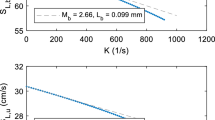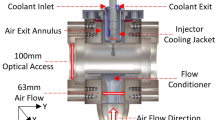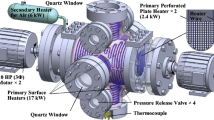Abstract
This study examines the effects of Residual Burnt Gas (RBG) field heterogeneity on Cycle-to-Cycle Variations (CCVs) under lean operation in Spark-Ignited (SI) engines. Direct Numerical Simulation (DNS) was used in conjunction with solving chemical kinetics for iso-octane/air mixtures to examine early premixed flame propagation. In SI engines, RBGs represent dilution by hot combustion products that remain from the previous engine cycle. Prior to investigating coupled effects, the opposing effects of temperature and dilution were first purposely isolated in order to quantify their respective contributions. To quantify the influence of RBG heterogeneity on actual engine CCVs, aerothermochemical conditions representative of low-load lean-burn engine operation were extracted from experimental data and engine large eddy simulation computations. Salient findings are as follows: (1) Standard RBG mixtures encountered in lean-burn SI engines increase laminar flame speeds because the positive effect of reactant temperature is dominant over the negative effect of dilution. (2) RBG heterogeneities create additional flame wrinkling even if no sensible enthalpy fluctuation is introduced. (3) For laminar flows, the statistical expansion of the flame kernel (averaged over multiple heterogeneity fields) occurs more quickly in heterogeneous mixtures than in homogeneous mixtures because of the non-linear laminar flame speed response to local temperature/dilution variations. (4) RBG heterogeneities encountered in lean-burn SI engines dramatically modify turbulent flame structures by either amplifying flame propagation in conducive conditions or quenching the flame when hostile conditions are encountered. (5) For turbulent flows, the statistical expansion of the flame kernel (averaged over multiple heterogeneity fields and turbulence draws) occurs more slowly in heterogeneous mixtures than in homogeneous mixtures because of the additional quenching that takes place when the flame encounters adverse thermodynamical conditions. (6) Typical RBG heterogeneities found in lean-burn SI engines lead to an additional cyclic variation in flame development of about 50 % compared with the isolated effect of turbulence.
Similar content being viewed by others
Abbreviations
- CCV:
-
Cycle-to-cycle variation
- DNS:
-
Direct numerical simulation
- FAER:
-
Fuel/Air equivalence ratio
- IMEP:
-
Indicated mean effective pressure
- LES:
-
Large eddy simulation
- PFI:
-
Port fuel injection
- RBG:
-
Residual burnt gas
- SI:
-
Spark-ignited
- α dil :
-
Rate of dilution by burnt gases
- δ f :
-
Laminar flame thickness
- Δ x :
-
Mesh size
- φ :
-
Fuel/air equivalence ratio
- σ :
-
Standard deviation
- τ c :
-
Chemical time
- τ t :
-
Turbulent time
- < >:
-
Ensemble-averaged over the simulation domain
- D a :
-
Damköhler number
- K a :
-
Karlovitz number
- L t :
-
Integral length scale
- L x,y,z :
-
Simulation domain size along x, y
- p :
-
Pressfure
- r 0 :
-
Initial flame radius
- r eq :
-
Flame equivalent radius
- Re t :
-
Turbulent Reynolds number
- \(S_{L}^{0}\) :
-
Laminar flame speed
- t final :
-
Final simulation time
- T ad :
-
Adiabatic flame temperature
- T fg :
-
Temperature of fresh gases
- u′:
-
Turbulent velocity fluctuations
References
Ozdor, N., Dulger, M., Sher, E.: Cyclic variability in spark ignition engines - a literature survey. SAE Paper 940987 (1994)
Aleiferis, P., Taylor, A., Ishii, K., Urata, Y.: The relative effects of fuel concentration, residual-gas fraction, gas-motion, spark energy and heat losses of the electrodes on flame-kernel development in a lean-burn spark ignition engine. Proc. Inst. Mech. Eng. D: J. Automob. Eng. 218, 411–425 (2004)
Aleiferis, P., Taylor, A., Ishii, K., Urata, Y.: The nature of early flame development in a lean-burn stratified-charge spark-ignition engine. Combust. Flame 136, 283–302 (2004)
Aleiferis, P., Hardalupas, Y., Taylor, A., Ishii, K., Urata, Y.: Flame chemiluminescence studies of cyclic combustion variations and air-to-fuel ratio of the reacting mixture in a lean-burn stratified-charge spark-ignition engine. Combust. Flame 136, 72–90 (2004)
Peterson, B., Reuss, D., Sick, V.: High-speed imaging analysis of misfires in a spray-guided direct injection engine. Proc. Combust. Inst. 33, 3089–3096 (2011)
Lacour, C., Pera, C.: An experimental database dedicated to the study and modelling of cyclic variability in spark-ignition engines with LES. SAE Paper 2011-01-1282 (2011)
Enaux, B., Granet, V., Vermorel, O., Lacour, C., Pera, C., Angelberger, C., Poinsot, T.: LES study of cycle-to-cycle variations in a spark ignition engine. Proc. Combust. Inst. 33, 3115–3122 (2011)
Granet, V., Vermorel, O., Lacour, C., Enaux, B., Dugué, V., Poinsot, T.: Large-Eddy Simulation and experimental study of cycle-to-cycle variations of stable and unstable operating points in a spark ignition engine. Combust. Flame 159, 1562–1575 (2011)
Rutland, C.: Large-Eddy Simulations for internal combustion engines - a review. Int. J. Eng. Res. 12, 421–451 (2011)
Zhao, F., Taketomi, M., Nishida, K., Hiroyasu, H.: PLIF measurements of the cyclic variation of mixture concentration in a SI engine. SAE Paper 940988 (1994)
Adomeit, P., Lang, O., Pischinger, S., Aymanns, R., Graf, M., Stapf, G.: Analysis of cyclic fluctuations of charge motion and mixture formation in a DISI engine in stratified operation. SAE Paper 2007-01-1412 (2007)
Sztenderowicz, M., Heywood, J.: Mixture nonuniformity effects on SI engine combustion variability. SAE Paper 902142 (1990)
Pera, C., Chevillard, S., Reveillon, J.: Effects of residual burnt gas heterogeneity on early flame propagation and on cyclic variability in spark-ignited engines. Combust. Flame 160, 1020–1032 (2013)
Lebel-Simon, M., Cottereau, M.J.: Simultaneous CARS measurements of temperature and CO2 concentration applied to the study of the effect of the residual gas fraction on combustion in an SI engine. In: Proceedings of the 3rd International Symposium on Modelling and Diagnostics in Internal Combust. Engines - COMODIA (1994)
Aleiferis, P.G., Taylor, A.M., Whitelaw, J.H., Ishii, K., Urata, Y.: Cyclic variations of initial flame kernel growth in a Honda VTEC-E lean-burn spark-ignition engine. SAE Paper 2000-01-1207 (2000)
Ghandhi, J., Bright, A., Herold, R.: Residual gas homogeneity measurements. Int. J. Eng. Res. 10, 121–132 (2009)
Pera, C., Richard, S., Angelberger, C.: Exploitation of multi-cycle engine LES to introduce physical perturbations in 1D engine models for reproducing CCV. SAE Paper 2012-01-0127 (2012)
Pera, C., Angelberger, C.: Large Eddy Simulation of a motored single-cylinder engine using system simulation to define boundary conditions: methodology and validation. SAE Paper 2011-01-0834 (2011)
Petersen, B., Ghandhi, J.: High-resolution turbulent scalar field measurements in an optically accessible internal combustion engine. Exp Fluids 51, 1695–1708 (2011)
Boudier, P., Henriot, S., Poinsot, T., Baritaud, T.: A model for turbulent flame ignition and propagation in spark ignition engines. Proc. Combust. Inst. 24, 503–510 (1992)
Reveillon, J., Pera, C., Bouali, Z.: Examples of the potential of DNS for the undestanding of reactive multiphase flows. Int. J. Spray Combust. Dyn. 3, 65–94 (2011)
Chauvy, M., Delhom, B., Reveillon, J., Demoulin, F.X.: Flame/wall interactions: laminar study of unburnt HC formation. Flow Turbul. Combust. 84, 369–396 (2010)
Lele, S.: Compact finite difference schemes with spectral like resolution. J. Comput. Phys. 103, 16–42 (1992)
Wray, A.: Minimal Storage Time-Advancement Schemes for Spectral Methods. Center for Turbulence Research Report, Stanford University (1990)
Hasse, C., Bollig, M., Peters, N., Dwyer, H.: Quenching of laminar iso-octane flames at cold walls. Combust. Flame 122, 117–129 (2000)
Kee, R.J., Miller, J.A., Jefferson, T.H.: CHEMKIN: a general-purpose, problem-independent, transportable, FORTRAN chemical kinetics code package, Sandia Natl. Lab. report (1980)
Halter, F., Foucher, F., Landry, L., Mounaim, C.: Effect of dilution by nitrogen and/or carbon dioxide on methane and iso-octane air flames. Combust. Sci. Technol. 181, 813–827 (2009)
Hult, J., Gashi, S., Chakraborty, N., Klein, M., Jenkins, K., Cant, S., Kaminski, C.: Measurement of flame surface density for turbulent premixed flames using PLIF and DNS. Proc. Combust. Inst. 31, 1319–1326 (2007)
Dunstan, T., Jenkins, K.: Flame surface density distribution in turbulent flame kernels during the early stages of growth. Proc. Combust. Inst. 32, 1427–1434 (2009)
Rogallo, R.: Numerical experiments in homogeneous turbulence. Tech rep, Technical Memorandum No. 81315 (1981)
Passot, T., Pouquet, A.: Numerical simulation of homogeneous flows in the turbulent regime. J. Fluid Mech., 181–441 (1987)
Hawkes, E., Chen, J.: Direct numerical simulation of hydrogen-enriched lean premixed methane-air flames. Combust. Flame 138, 242–258 (2004)
Dunstan, T., Jenkins, K.: The effects of hydrogen substitution on turbulent premixed methane-air kernels using direct numerical simulation. Int. J. Hydrogen. Energy 34, 8389–8404 (2009)
Jenkins, K., Klein, M., Chakraborty, N., Cant, R.: Effects of strain and curvature on the propagation of a spherical flame kernel in the thin-reaction-zones regime. Combust. Flame 145, 415–434 (2006)
Chakraborty, N., Cant, R.: Direct numerical Simulation analysis of the flame surface density transport equation in the context of large eddy simulation. Proc. Combust. Inst. 32, 1445–1453 (2009)
Chakraborty, N., Cant, R.: Effects of Lewis number on flame surface density transport in turbulent premixed combustion. Combust. Flame 158, 768–1787 (2011)
Reveillon, J.: Numerical procedures to generate and to visualize flow fields from analytical or experimental statistics: turbulent velocity, fluctuating scalars and variable density sprays. J. Flow Vis. Image Proc. 12, 1–19 (2005)
Wu, X., Moin, P.: Large-activation-energy theory for premixed combustion under the influence of enthalpy fluctuations. J Fluid Mech., 3–37 (2010)
Author information
Authors and Affiliations
Corresponding author
Rights and permissions
About this article
Cite this article
Pera, C., Knop, V., Chevillard, S. et al. Effects of Residual Burnt Gas Heterogeneity on Cyclic Variability in Lean-burn SI Engines. Flow Turbulence Combust 92, 837–863 (2014). https://doi.org/10.1007/s10494-014-9527-7
Received:
Accepted:
Published:
Issue Date:
DOI: https://doi.org/10.1007/s10494-014-9527-7




